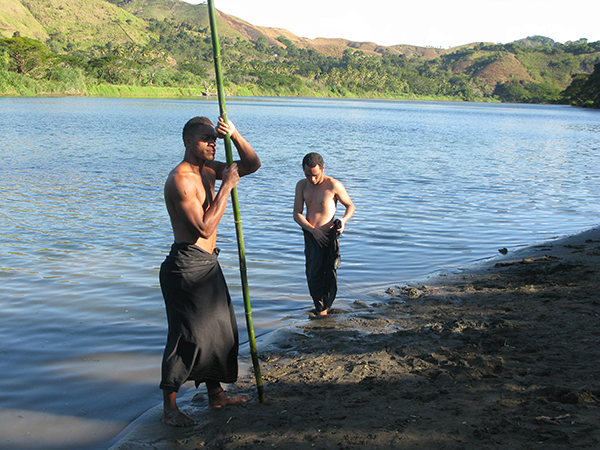Sorry for the delay in blogging, but it’s been an extremely busy two weeks and I have had no time to get on the computer and write an update. Because so much has happened in the last two weeks, I will have to break up this update into three separate blog postings. Here’s the first with more to come:
After Alexi and I had been alone for a couple of weeks preparing for production, our intern Matt Bikoff arrived. Matt is a UC Berkeley student with an interest in history and film, and he has been helping us for the last several months. When he heard we were going to Fiji, he asked if he could join us and learn about production and we were happy to bring him on.

Matt was here about a week before the others arrived, and he helped with logging our notes and contacts as well as doing research at the Fiji National Archives. At the end of our week together, we decided to take a day off. Our new friend Suva expat Kerry Barker told us that if you go to the Royal Suva Yacht Club on Sunday afternoons, you can hitch a ride on one of the sailboats that engage in weekly friendly races there. We followed her lead and, sure enough, a nice Danish fellow named Ingolf Nielsen offered to take Alexi, Matt, and me in his boat. Unfortunately, the wind was not consistant enough for the race and the competition fizzled out. That’s ok, because it was a lovely afternoon, and we enjoyed hearing Ingolf tell about his adventures sailing across the Atlantic and the Pacific over the course of the last year. He will be embarking for his final destination of New Zealand as soon as the tradewinds arrive in a month or so to blow him there!
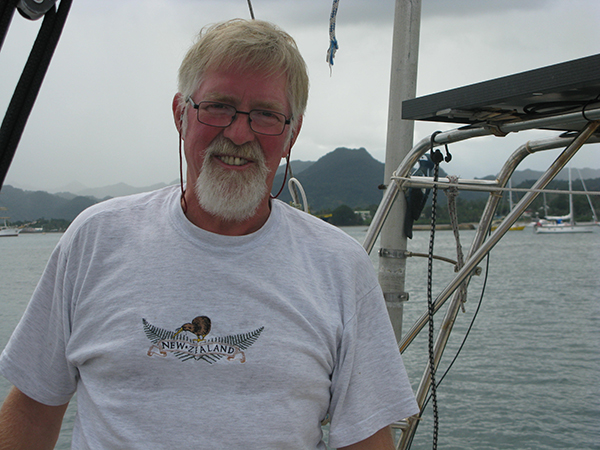
Then our cinematographer Smith, our sound recordist Anton, and their four-year-old son Dari arrived. Smith is a graduate film school classmate and longtime friend of Alexi’s and she has been our camera person since production started on our first visit in 2008. Anton and Dari joined the production on our second trip in 2011. Smith and Anton are accomplished professionals and they are donating their time, expertise and equipment to the production because of their belief in the project. It has been a pleasure working with them as it has been watching Dari grow up on set.

Arriving next were the moms, Jean and Anne. Jean (aka Mumsy), is Alexi’s mom, of course, and she is the “star” of our production, having grown up in Fiji and much of the film being about her return here. Anne is my mom and she came along to be a companion to Jean, help out where she could, and to experience production in the South Pacific. At this point, all our team members were here and we were ready to start shooting!
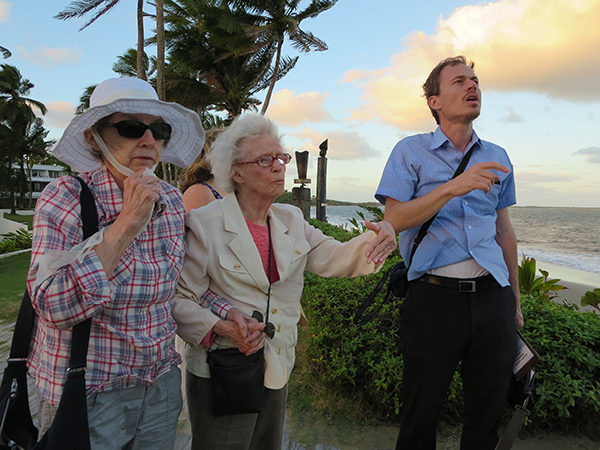
Shooting started in Sigatoka. Our first interview was with Jason Tutani, the Park Manager of the Sigatoka Sand Dunes National Park. Jason spoke about pre-colonial Fiji as well as his own family history. The sand dunes are an archeological site as well as being a beautiful park, and Jason talked about the first peoples who came to Fiji on boats across the Pacific. His knowledge of the indigenous people and culture of the islands was illuminating. In addition, he discussed his own family story, which is quite fascinating, being comprised of European, native Fijian, and Indian heritage. In this way, Jason is a reflection of the nation of Fiji itself, with all its richness and complexity. Within this context, he also talked about the challenges that he and his family have faced coming from a mixed-race background.

Our next interview was with Rup Beo, who is the uncle of our assistant director Aarti (“Arts”) Mala. First, let me tell you about Arts. She discoved Fiji Time online and reached out to Alexi from Fiji when we were still in California. When we arrived here, Alexi met with her and immediately recognized her as someone with intelligence, energy and a can-do spirit. Arts is a Fijian of Indian descent who has worked on film productions here in the past. We immediately signed her up as assistant director for the reenactment shoots.
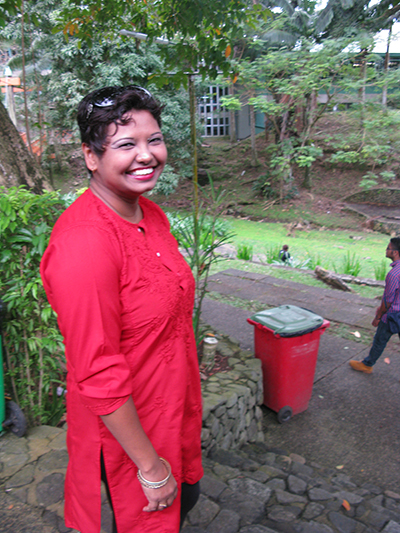
Rup is Art’s uncle and his father recently died at the age of 105. His father had told Rup many stories over the years about the girmit (indenture) era, and Rup shared these stories with us. Indenture was a very difficult life for the girmitiyas, but their sacrifices enabled their children and grandchildren to have a better life in Fiji. One of the most amazing parts of the interview was when Rup brought out his father’s gramophone and a couple of old records. Based on his small salary, it would have taken Rup’s father six months to save enough money to buy the gramophone, so, needless to say, this was a prized possession for the family. Rup wound the crank of the ancient record player, put on a 78 of old Indian music, and we watched him listen intently to the beautiful music while he fought back tears.
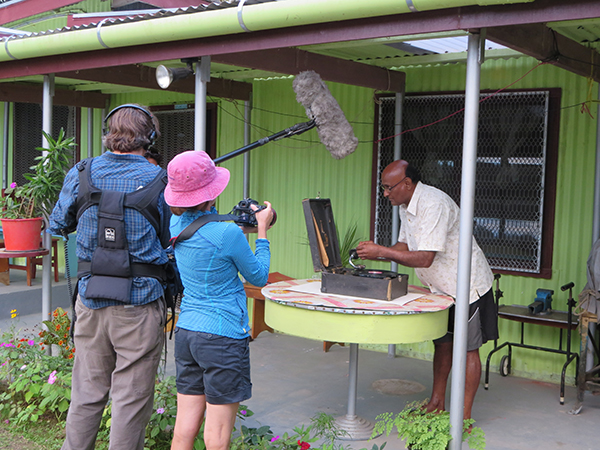
The next day was a big production day, as we had a dramatic reenactment to shoot. For those of you who have seen the trailer, you will know the G.H. and Enoki scene. That’s the one where I (as G.H., Jean’s great-grandfather) fight with and end up shooting the Fijian schoolteacher and “trespasser”, Enoki. When we initially shot this, it was at the Russian River in California with a non-Fijian actor playing Enoki. Fijians who saw this footage told us that they could tell that it was not shot in Fiji and that the actor was not Fijian. Therefore, we decided to shoot it again more authentically.
First, where to shoot? Well, how about the place that it actually happened? As I mentioned in my earlier blog (See Blog 3.1 below), Alexi and I had already discovered where Enoki’s village had been and met Joveci Nakubu, whose family had lived there for generations (and had therefore been taught by Enoki at one point). Meeting back up with Joveci after two weeks, we found out that he had acquired additional historic documents from a neighboring village archive, and that these documents proved that G.H.’s land was indeed on the land adjacent to Jo’s land where a vocational training center now stood.
We originally intended to shoot the reenactment on Jo’s land, but once we saw how steep and challenging his river access was (this, of course, is why Enoki went to G.H.’s land to access the river on that fateful day in 1879), and learning that G.H.’s land was next door, I asked at the vocational training center if we could shoot on their property. They kindly agreed and we had the actual location for the reenactment! The next problem was actors. We were lucky enough to get Filipe Vuli, an accomplished actor from Suva to agree to take a bus to Sigatoka and star as Enoki for lunch and expenses. Filipe is a brilliant actor and we are thankful to him (and Anurag Subramani, University of South Pacific professor, filmmaker, and and a advisor to our film, who recommended him!). The problem was not with this role, but with that of Pita (“Peter”) the other Fijian role we needed to cast. We did not have an actor for this role and we were ready to shoot.
When we arrived at the vocational centre, I noticed a group of young men getting job training in construction. I went to the instructor/foreman and told him what we were doing and that we needed an actor. I basically asked if any of the young men were interested in getting some supplemental vocational training with us in acting! Luckily for us, one Napolioni Cati agreed! Tall, muscular, and a surprisingly natural actor, he was perfect for the role!
More to come…
